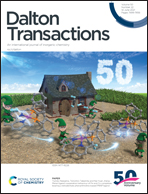Hydroquinone/quinone electro- and photochemical interconversion in isolable polypyridylruthenium(ii) complexes†
Abstract
Quinone derivatives and their metal complexes are well-known molecules that participate in electron-transfer reactions relevant to diverse fields. However, the fundamental knowledge on the unique reactivity of redox-active quinone complexes is limited by the difficulty in their isolation. Herein, the synthesis of isolable mononuclear polypyridylruthenium(II) complexes containing both hydroquinone and quinone units is described. Three types of monodentate ligands are conveniently used to control the electronic states of the complexes. Both reduced (hydroquinone) and oxidised (quinone) forms are successfully isolated and characterised by spectroscopic and crystallographic analysis, allowing direct comparisons of their properties. The redox-rich and visible light-responsive nature of the ruthenium complexes enables to investigate the quinone/hydroquinone interconversion induced by electron transfer, photoirradiation and photoswitching based on ligand substitution reactions. These results demonstrate the occurrence of synergistic effects between metal complexes and redox-active organic compounds.



 Please wait while we load your content...
Please wait while we load your content...